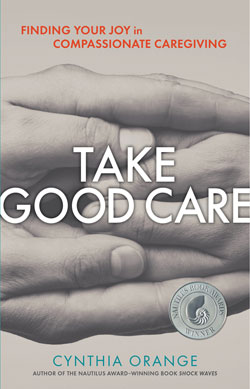
"When we practice "boundaried empathy" with someone, we can open ourselves to compassion."

Other titles you may like.

Shock Waves: A Practical Guide to Living
with a Loved One's PTSD

If You Leave Me, Can I Come With You?
Visit Recovery Road to view and
listen to all the episodes.
Episode 91 -- February 25, 2021
The Road to Compassion Goes Through Empathy
Whether you're actively caring for someone as they recover from an illness or injury or simply working to be of service in your own recovery, developing your innate human empathy is a worthwhile task. Healthy empathy allows us to offer genuine comfort, service, and understanding to others without getting overwhelmed by the other person's feelings or experience. This has benefits that extend far beyond caregiving.
In this excerpt from her book Take Good Care: Finding Your Joy in Compassionate Caregiving, author Cynthia Orange invites us to regularly exercise our "empathy muscles." As we do, each of our interactions and relationships will benefit from more compassion, patience, understanding, and kindness.
This excerpt has been edited for brevity.
Empathy: The First Stop on the Road to Compassion
I've heard empathy commonly described as putting yourself in someone else's shoes, but I think it's more than that. Unless we're mind readers, we cannot know for certain what another person is feeling or thinking—even if we have experienced something similar to what they are going through. Our car accident is not their car accident; our illness is not their illness; our loss is not their loss—even though we might be grieving the same person or pet or thing. When something significant happens in our lives, we respond in our own unique way. Our own history, our own personality, our own understanding and knowledge, our own thoughts, and our own feelings shape the way we internalize and react to a situation or event.
The word empathy comes from a Greek work that means "in feeling" or "feeling into."
Unlike Commander Troi, the half-human, half-alien empath in the old science fiction television series Star Trek: The Next Generation, we normal human beings cannot literally feel exactly what another person is feeling. She had the ability to physically and psychically take on another's pain or anguish. To me, being "in feeling" means feeling with someone.
I don't mean to say that we can't be affected by what someone else is going through. When my husband first opened up to me about his experiences as a Marine in Vietnam, I was deeply affected by his stories. I could not be him, but I could be with him. Here's how I described this in previous writings:
I listened to his stories deep into that night and began to ache from the weight of that terrible war. Of course, I couldn't know what it was like to actually be there, but his descriptions of burning villages made my eyes sting. I imagined the villagers hugging themselves tight in fear and grief, as I drew a blanket tightly around me. I still remember the name of the little cat—Titi Lau—that was eaten by the rats. As he talked, I felt like I walked in jungle heat with him. Through his eyes, I saw two little boys get ripped apart by machine guns after they set off a homemade bomb that killed Michael's fellow Marines.
Michael put the photographs back into their envelope, stuffing them and the memories away in his sea bag, and we didn't talk about these things until years later. But the stories and images stayed with me and even invaded my dreams on occasion. I was glad Michael trusted me enough to tell me his war stories, but in gaining his confidence I also lost something that night. The world seemed more fragile, less certain; a darker place where little boys and 19-year-olds could be made to kill and be killed. I grew more protective of our daughter, and more fearful for myself and those I loved.
When Michael was diagnosed with PTSD many years later, I learned the hard way about healthy balance and boundaries and the difference between "caretaking empathy" and "caregiving empathy." I was definitely on the caretaking/enmeshed side of the continuum discussed in previous chapters when he had an emotional crash and began intensive therapy. I wanted so desperately to support this man I loved, becoming so tangled up in what he was going through that I also ended up in therapy for depression. I made the initial appointment thinking I would get help with how I might best support Michael, but when my intuitive therapist asked, "But who is helping you with your war?" I broke down sobbing, and, with her guidance, came to realize that I could not genuinely care for and support my husband if I was not taking good care of myself. I learned I could hear his story without becoming his story. That, to me, is caregiving and healthy empathy. It involves self-care and good balance and boundaries.
When we practice "boundaried empathy" with someone, we can open ourselves to compassion. We are, as Stephen Levine describes it, able to touch their pain with love. We can listen attentively and pay attention to their body language to get a sense of how deeply a trauma or event is affecting them. We can hold them, cry or laugh with them, comfort them, and support them. We can feel with them.
Here's how Suzanne described her personal journey in empathy and caregiving.
One of my new lines is "everyone has their shit." Everyone's stuff is different, and this is the difficult stuff we're dealing with right now. I try to remember that everyone everywhere is struggling with some difficulty a lot of the time, from worrying about grown children's issues, a grandchild with strep throat, or an ailing parent. Everyone cares deeply about something that isn't going well in their lives. Everyone is hurting, struggling, tired in some sense, and we need to be the kindest person we can be at every opportunity. One bright person in a grocery line can brighten my day. I want to be that for someone else. So my mantra is, "Let me bring light to someone else. Let me be less critical and judging and more accepting. Let me be a better version of me. Let this experience enable me to hold someone else up through their journey in a better way. Let me be a better listener and offer fewer solutions. Let me help someone else suffer less some of the time. Let me be a better person." I guess that is what I want from this experience in caregiving.
In an article titled "What Is Empathy?" experts at the University of California, Berkeley's Greater Good Science Center explain the difference between "affective empathy" (sometimes called "emotional empathy") and "cognitive empathy." According to them, affective empathy relates to the feelings we have in reaction to other people's emotions. They write that "this can include mirroring what that person is feeling, or just feeling stressed when we detect another's fear or anxiety." They state that cognitive empathy, which is sometimes called "perspective taking," is about "our ability to identify and understand people's emotions."
But I also believe that even if we do have the capacity to empathize, it also takes self-awareness and practice to fine-tune our empathetic natures—especially when it comes to caregiving. In fact, doing favors, volunteering, caring for and about others, and just plain being kind are all ways to practice empathy and strengthen our ability to empathize. As the familiar saying goes, "If we don't use it, we lose it."
About the Author:
Cynthia Orange is a writer, editor, and writing consultant. Her books include Shock Waves: A Practical Guide to Living with a Loved One's PTSD (Hazelden Publishing, 2010) and Sing Your Own Song (Hazelden Publishing, 2001), and she is the coauthor of New Life, New Friends (Bantam, 1993) and a contributor to Today's Gift (Hazelden Publishing, 1985). She has received awards for creative nonfiction, poetry, essays, and newspaper articles.
Orange co-facilitates a group for caregivers of a variety of ages and circumstances that was founded in 2010. She has written extensively about caregiving and post-traumatic stress disorder, and she and her husband, Michael, a Vietnam combat veteran, often speak to audiences about the effects of trauma and war in their continuing involvement with veterans and veterans' issues.
© 2017 by Cynthia Orange
All rights reserved

